Buenos Aires – The Palio opened up, I believe, on Sunday night, at least according to all my sources. Not that they run the Palio here in Argentina, though there are certainly enough horses and races around, but to the best of my knowledge it continues in its traditional location of Siena, Italy. On the other hand, given my love of Italian food, it made a perfect choice for a dinner theme when a group of my regular readers who are spending a term in school here wanted to come for dinner. In fact, as I found out later, apparently they follow my scribblings sufficiently that their weekly group dinner over the last few months has tended to head them towards one of my recommendations each week. Gratifying and a bit scary, I feel like I’m warping young minds… but then, it’s only food, right?
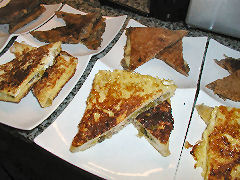 Dinner started off with the idea of bruschetta, those traditional little toasts topped with tomatoes or beans or what-have-you. I had the bruschetta that I’d tried at Craftbar a few weeks back on my mind at the time, and knew I wanted to do something similar to that. I also wanted to do something with mushrooms, based on the panini that I’d had there as well. As the date approached, the panini idea became more interesting, it’s less messy, and I was already seeing that this was going to be a bread/starch intensive meal, so I wanted to lighten it up a touch and use a thin, lighter bread. I decided to more or less make mini-grilled cheese sandwiches. So for one I made a duxelles of portobello and oyster mushrooms on white bread, then topped it with grated fontina cheese, and grilled straightfoward. The other, the filling was smoked white anchovies and caramelized leeks (caramelized with a little leftover sweet wine) on whole wheat bread, and rather than trying to soft cook nine eggs perfectly and situate them into the sandwiches, I decided to make them more like french toast sandwiches. I think I would have liked them a little crispier than they turned out, but I liked the flavors. Accompanying wine, Nieto Senitener Extra Brut sparkling made from 100% Pinot noir, in Mendoza, nice way to start the evening.
Dinner started off with the idea of bruschetta, those traditional little toasts topped with tomatoes or beans or what-have-you. I had the bruschetta that I’d tried at Craftbar a few weeks back on my mind at the time, and knew I wanted to do something similar to that. I also wanted to do something with mushrooms, based on the panini that I’d had there as well. As the date approached, the panini idea became more interesting, it’s less messy, and I was already seeing that this was going to be a bread/starch intensive meal, so I wanted to lighten it up a touch and use a thin, lighter bread. I decided to more or less make mini-grilled cheese sandwiches. So for one I made a duxelles of portobello and oyster mushrooms on white bread, then topped it with grated fontina cheese, and grilled straightfoward. The other, the filling was smoked white anchovies and caramelized leeks (caramelized with a little leftover sweet wine) on whole wheat bread, and rather than trying to soft cook nine eggs perfectly and situate them into the sandwiches, I decided to make them more like french toast sandwiches. I think I would have liked them a little crispier than they turned out, but I liked the flavors. Accompanying wine, Nieto Senitener Extra Brut sparkling made from 100% Pinot noir, in Mendoza, nice way to start the evening.
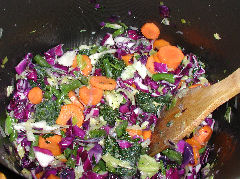 Winter time and we’re still on those hearty soups. Tuscany, of course, has many, but one of its classics is the ribollita, or bread and vegetable soup. There are probably as many recipes for this soup as their are Tuscans, but the basic premise is a mix of white beans, cabbage, and other vegetables, and served over a slice of stale bread. I’m not big on stale bread except in bread pudding. I know its traditional, but instead I went with freshly made garlic toasts. You still get a nice crispy texture, but the bread tastes fresher, and I wanted the added touch of garlic on it. The soup, like many, is best flavorwise if cooked a day ahead of time and allowed to sit.
Winter time and we’re still on those hearty soups. Tuscany, of course, has many, but one of its classics is the ribollita, or bread and vegetable soup. There are probably as many recipes for this soup as their are Tuscans, but the basic premise is a mix of white beans, cabbage, and other vegetables, and served over a slice of stale bread. I’m not big on stale bread except in bread pudding. I know its traditional, but instead I went with freshly made garlic toasts. You still get a nice crispy texture, but the bread tastes fresher, and I wanted the added touch of garlic on it. The soup, like many, is best flavorwise if cooked a day ahead of time and allowed to sit. 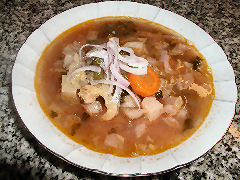 It’s a shame that at the same time, that sitting leaches the vibrant colors out of the vegetables, especially the red cabbage, resulting in a soup gone more or less beige-pink. Still, it develops the flavor so much better, and continuing on – the day after I think the soup was even more flavorful! First I cooked down some white onions, leeks, and garlic n olive oil, until transluscent. Then added carrots, green beans, white and red cabbage, and spinach to the mix, stirring to make sure they were well coated with the olive oil. I continued to cook those until the vegetables were just getting a touch caramelized. Added the white beans which had been soaking overnight, filled it up with water, brought it to a boil, reduced the heat, and simmered until the beans were done. Then left it to cool and sit overnight. Next day reheated, and served ladled over the garlic toasts and topped with shavings of red onions. The wine, Humberto Canale Semillon 2004 from Patagonia, nice, crisp, citrusy, and a touch of oak, providing a good balance with the soup.
It’s a shame that at the same time, that sitting leaches the vibrant colors out of the vegetables, especially the red cabbage, resulting in a soup gone more or less beige-pink. Still, it develops the flavor so much better, and continuing on – the day after I think the soup was even more flavorful! First I cooked down some white onions, leeks, and garlic n olive oil, until transluscent. Then added carrots, green beans, white and red cabbage, and spinach to the mix, stirring to make sure they were well coated with the olive oil. I continued to cook those until the vegetables were just getting a touch caramelized. Added the white beans which had been soaking overnight, filled it up with water, brought it to a boil, reduced the heat, and simmered until the beans were done. Then left it to cool and sit overnight. Next day reheated, and served ladled over the garlic toasts and topped with shavings of red onions. The wine, Humberto Canale Semillon 2004 from Patagonia, nice, crisp, citrusy, and a touch of oak, providing a good balance with the soup.
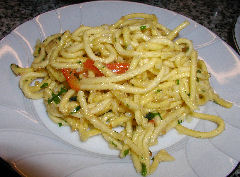 At this point, of course, a proper mid-course of pasta. One of the most traditional local dishes in Siena is a pici alle briciole. This is a basic white flour, water, and olive oil pasta, sort of a thick spaghetti. Traditionally it should be hand rolled and a bit malformed. My local pasta guy, who last time refused to make semolina pasta (okay, he had no idea what semolina flour was), was willing to make these, but not hand rolled. So I got die-cut versions. I also think, based on the color, that he added some egg to the mixture. I’ll have to play with this one myself to see what I can come up with. The sauce is very simple, and works well with any similar pasta – saute a large amount of garlic (I used a full large clove per person) in a large amount of olive oil until just lightly golden, then add breadcrumbs in about double that amount, and continue sauteing until all is somewhat browned. Add thinly slivered hot peppers – I used rocotos, since those are what are available here, again, a fair amount, equal in volume to the garlic. Undercook your pasta slightly more than usual, and then finish cooking it by tossing it in this mixture and giving it a slight frying itself. At last minute toss in some parsley and adjust the salt to taste. For wine, we started in on Sangiovese, the classic red grape of Tuscany, with Rodas Coleción Sangiovese Rosado 2005
At this point, of course, a proper mid-course of pasta. One of the most traditional local dishes in Siena is a pici alle briciole. This is a basic white flour, water, and olive oil pasta, sort of a thick spaghetti. Traditionally it should be hand rolled and a bit malformed. My local pasta guy, who last time refused to make semolina pasta (okay, he had no idea what semolina flour was), was willing to make these, but not hand rolled. So I got die-cut versions. I also think, based on the color, that he added some egg to the mixture. I’ll have to play with this one myself to see what I can come up with. The sauce is very simple, and works well with any similar pasta – saute a large amount of garlic (I used a full large clove per person) in a large amount of olive oil until just lightly golden, then add breadcrumbs in about double that amount, and continue sauteing until all is somewhat browned. Add thinly slivered hot peppers – I used rocotos, since those are what are available here, again, a fair amount, equal in volume to the garlic. Undercook your pasta slightly more than usual, and then finish cooking it by tossing it in this mixture and giving it a slight frying itself. At last minute toss in some parsley and adjust the salt to taste. For wine, we started in on Sangiovese, the classic red grape of Tuscany, with Rodas Coleción Sangiovese Rosado 2005
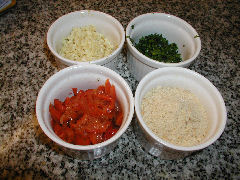
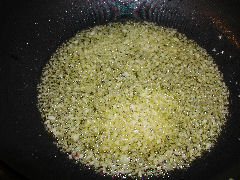
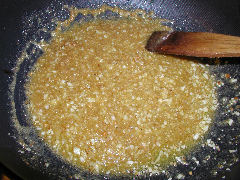
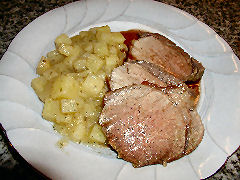 The main course, roast beef with a Sangiovese sauce. The beef, crusted with coarse salt and cracked peppercorns and simply roasted to about medium (raw according to Henry, who wouldn’t touch it), which seemed about right for most folk. The sauce, simply deglazing the roasting pan with a little Sangiovese based wine, a touch of salt and pepper, and finishing it with some butter. Accompanied by potatoes that were sauteed in olive oil, garlic, lemon juice, and oregano, one of my personal favorites. You can also just roast them in a mixture of all that (water too, in both cases, the potatoes need to absorb a bit). With this dish, a nice, rich, full bodied Roca Bonarda-Sangiovese from Mendoza. I didn’t notice in advance, but the two bottles were different vintages, 2003 and 2004, however I tasted them as I opened them, and they were nearly identical.
The main course, roast beef with a Sangiovese sauce. The beef, crusted with coarse salt and cracked peppercorns and simply roasted to about medium (raw according to Henry, who wouldn’t touch it), which seemed about right for most folk. The sauce, simply deglazing the roasting pan with a little Sangiovese based wine, a touch of salt and pepper, and finishing it with some butter. Accompanied by potatoes that were sauteed in olive oil, garlic, lemon juice, and oregano, one of my personal favorites. You can also just roast them in a mixture of all that (water too, in both cases, the potatoes need to absorb a bit). With this dish, a nice, rich, full bodied Roca Bonarda-Sangiovese from Mendoza. I didn’t notice in advance, but the two bottles were different vintages, 2003 and 2004, however I tasted them as I opened them, and they were nearly identical.
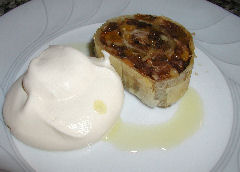 Finished up the evening with a dessert I was quite happy with. You may have noticed I tend to like strange desserts. I started with the classic Tuscan Chestnut Cake. It’s a cake that I really like the flavors of, but have never been fond of the texture. It’s sort of dry and crumbly, and is classically dipped in Vin Santo to eat – sort of the cake equivalent of biscotti. I decided to stick with the flavors, but keep them fresh and vibrant. So, I made a filling of candied chestnuts, golden raisins, toasted walnuts and pinenuts, brown sugar, and a small amount of chopped fresh rosemary. I rolled the whole thing up in strudel dough that was buttered and brown sugared between the layers, then baked it until golden brown (let it go a little extra long, remember, with the strudel rolled up, you’ve got dough in the center that needs to cook). Topped the whole things with a scoop of rosemary infused whipped cream and a drizzle of good olive oil. They all looked at me very strangely when we presented it and I described it, but I didn’t notice a whole lot of crumbs left on plates… Served with some imported plum liqueur from Italy called Prugna Mandorlata – it’s not from Siena, but from Friuli, but it worked well with the strudel.
Finished up the evening with a dessert I was quite happy with. You may have noticed I tend to like strange desserts. I started with the classic Tuscan Chestnut Cake. It’s a cake that I really like the flavors of, but have never been fond of the texture. It’s sort of dry and crumbly, and is classically dipped in Vin Santo to eat – sort of the cake equivalent of biscotti. I decided to stick with the flavors, but keep them fresh and vibrant. So, I made a filling of candied chestnuts, golden raisins, toasted walnuts and pinenuts, brown sugar, and a small amount of chopped fresh rosemary. I rolled the whole thing up in strudel dough that was buttered and brown sugared between the layers, then baked it until golden brown (let it go a little extra long, remember, with the strudel rolled up, you’ve got dough in the center that needs to cook). Topped the whole things with a scoop of rosemary infused whipped cream and a drizzle of good olive oil. They all looked at me very strangely when we presented it and I described it, but I didn’t notice a whole lot of crumbs left on plates… Served with some imported plum liqueur from Italy called Prugna Mandorlata – it’s not from Siena, but from Friuli, but it worked well with the strudel.
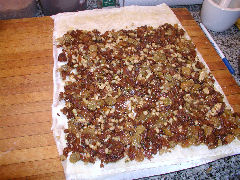
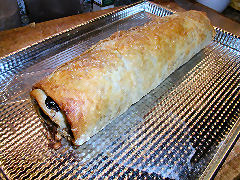
[…] Buenos Aires – Much as the Palio kicked off last week, a chance for much Italian regional pride and competition, the encierro kicked off yesterday, a chance for much idiocy and injury, as folks attempt to chase, be chased, and hopefully outrun, a bunch of stampeding cattle. My job isn’t to critique those folks who seem to get a thrill out of danger seeking and potential injury and/or death, but to somehow capture the moment on a dinner plate. Which basically means I do nothing but come up with some sort of inspiration and turn it into a menu. Then cook it. The encierro is set in Pamplona, a town in the Navarra region of Spain, so the food of that region became the basis for my plan. A half dozen folk came to last night’s Casa dinner, a shame for the half dozen who didn’t fill the empty seats, at least in my view! […]
[…] Buenos Aires – A couple of weeks ago I posted about our dinner celebrating the opening of the Paliio. The pasta dish, a classic of Sienese cooking, was pici all’aglione, a very simple preparation in the final analysis – the pasta simply tossed with freshly sauteed breadcrumbs, garlic, hot peppers, and parsley. I had mentioned that my local pasta guy would only make me die-cut versions of pici, which, in reality, were just fat spaghetti – or bucatini. I wanted to get back to the pasta itself (the preparation is now something I’m making regularly, even with other pastas – it’s so simple and so good!) – and a couple of nights ago I decided to spend the evening making handrolled pici. It’s definitely an activity to plan when you have lots of time. […]
[…] Aires – Three years ago this last weekend we offered up a dinner in honor of the Palio, the annual horse race in Siena, with a menu of local favorites. This year, […]
[…] From the Italian book, the random recipe was a traditional Tuscan chestnut cake with rosemary, pinenuts, and raisins. I have reimagined this a couple of times over the years – the most successful being a chestnut strudel back in 2006. […]